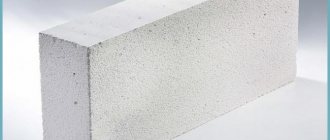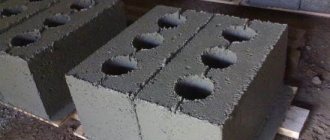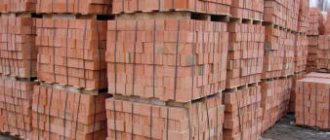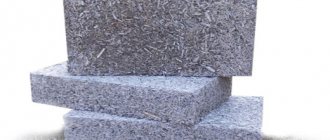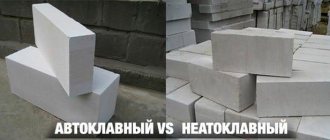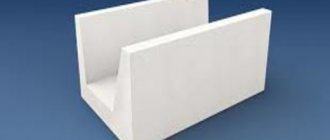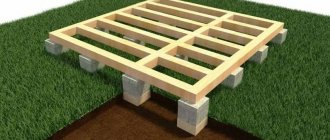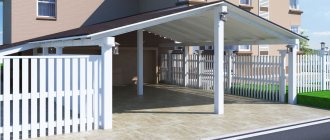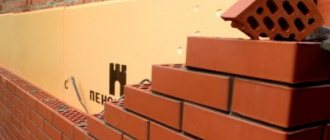Gas silicate brick confidently occupies a leading position in the building materials market. The material has gained such popularity due to its unique technical characteristics that meet the requirements of the modern world. In addition, the quality and price of the bricks correspond to each other.
Despite the fact that gas silicate material appeared relatively recently, it has stood the test of time and successfully performs its stated functions.
The material is used for the construction of any structures, as well as buildings for various purposes.
What are gas silicate blocks?
Gas silicate block products are a modern building material made from the following raw materials:
- Portland cement, which is a binding ingredient;
- quartz sand introduced into the composition as a filler;
- lime involved in the gas formation reaction;
- powdered aluminum added to foam the mass.
When mixing the components, the working mixture increases in volume as a result of an actively occurring chemical reaction.
Gas silicate blocks are widely used in the construction industry
Molding containers filled with silicate mixture harden under various conditions:
- naturally at ambient temperature. The hardening process lasts 15-30 days. The resulting products are characterized by a reduced cost, but have insufficiently high strength;
- in autoclaves, where products are heated at high pressure. Steaming allows you to increase the strength characteristics and specific gravity of gas silicate products.
Density and strength indicators change depending on the manufacturing method. The specified characteristics of the materials determine the area of use.
Blocks are divided into the following types:
- products for structural purposes. They are marked D700 and are in demand for the construction of permanent walls, the height of which is no more than three floors;
- thermal insulation and structural products. Brand D500 corresponds to these blocks. They are used for the construction of internal partitions and the construction of load-bearing walls of small buildings;
- thermal insulation products. They are characterized by increased porosity and density reduced to D400. This allows the use of gas silicate material for reliable thermal insulation of walls.
The digital index in the block markings corresponds to the mass of one cubic meter of gas silicate, indicated in kilograms. As the density of the material increases, its thermal insulation properties decrease. Products of the D700 brand are gradually replacing traditional brick, and products with a density of D400 are not inferior in thermal insulation properties to modern insulation materials.
Gas silicate blocks are superior in mechanical strength to foam concrete
This is interesting: Pouring a foundation into the ground without formwork: Pros and cons and the result obtained
Gas silicate blocks - what are they?
In simple terms, gas silicate material is one of the types of cellular concrete. The finished material was porous, but had the same characteristics as concrete. The difference was that due to the porous structure, the blocks had less weight. The material was obtained by adding special additives to the concrete solution that form pores. In the 19th century, the solution was mixed with the blood of an ox or pig to obtain this effect. Protein in the blood, reacting with other components, formed foam. One of the Soviet builders, M. N. Bryushkov, noticed in the 1930s that the soap root plant, which grows in Central Asia, gives cement a new feature. When the plant was added to the mixture, it began to foam, thereby increasing in volume. When the solution hardened, the porous structure was preserved. However, the most important role in the production of cellular concrete was played by Albert Erickson, an architect from Sweden, who developed the technology for producing the material by adding chemical gas-forming components. He patented his invention. But what are aerated silicate bricks made of today?
Based on SN 277-80, the aerated concrete solution must consist of the following components:
- high quality Portland cement, prepared in accordance with GOST 10178-76, which contains calcium silicate, not less than 50%, tricalcium aluminate, not more than 6%. Tripod cannot be added to the composition;
- sand, with technical requirements in accordance with GOST 8736-77, in which clay and silty inclusions do not exceed 2%, and the presence of quartz is 85%;
- plain water that meets the requirements of GOST 23732-79;
- calcium lime-lime, corresponding to GOST 9179-77, not less than grade 3. Its extinction speed should be 5–15 minutes. and no more than 2% burnout. Magnesium oxide and calcium oxide in the composition - not less than 70%;
- aluminum powder PAP-1 or PAP-2, used as a gas generator;
- sulfanol C, surfactant.
You can see what a gas silicate brick looks like in the photo below.
It is from these components that aerated silicate bricks are produced. It is noteworthy that finished products made from gas silicate mixture can be divided into 2 types:
They differ in the manufacturing method. Gas silicate bricks from an autoclave, thanks to special processing in it, have increased shrinkage during drying (5 times better) and strength. Production in an autoclave is quite technologically advanced and energy-intensive, so their price is slightly higher. Drying of gas silicate bricks occurs at a temperature of 175 ˚C, under a pressure of 0.8–1.2 MPa. Only large enterprises can afford such processing.
As for non-autoclaved gas silicate bricks, its production is much cheaper, but with slightly worse performance. The prepared mixture hardens in natural conditions, without external influence.
What you need to know: description
To obtain it, the following composition is used:
- the role of the binding component according to GOST 10178-76 is Portland cement, as well as calcium boiling lime;
- silicate component as a filler;
- process water;
- Aluminum powder plays the role of a gas-forming additive here.
What is the best adhesive for gas silicate blocks you can choose from this article.
Thanks to this composition, it is possible to obtain an active chemical reaction, which will result in the formation of a large amount of hydrogen. This component foams the concrete solution, which, after hardening, forms a highly porous material with excellent thermal insulation properties.
To produce gas silicate houses, an autoclave can be used or without it. Thanks to the autoclave method, it is possible to produce products with high strength characteristics and also eliminate shrinkage during drying.
Aerated concrete, foam concrete or gas silicate blocks, which is better to choose for construction, can be found out in the article.
If the production process involves the absence of an autoclave, then the resulting products will have high shrinkage and also have low strength indicators. However, such blocks have one significant advantage - low cost.
The video describes the technical characteristics of gas silicate blocks:
You can find out which gas silicate blocks are best used for building a house from this article.
The autoclave production method is used in large enterprises, because this method is very technological and requires high power consumption. The process of steaming the finished product is carried out at a temperature of 200 degrees and a pressure of 1.2 MPa. At the same time, when compared with other materials, the thickness of walls made of aerated concrete will not differ much.
By measuring the percentage of components that make up a gas silicate block, you can change its characteristics . If you increase the amount of cement, you can increase the strength of the material, but the number of pores will then decrease. As a result, this will affect the thermal characteristics of the material, increasing the thermal conductivity value.
What is the difference between a foam block and a gas silicate block can be learned from this article.
Gas silicate blocks boast the following positive properties:
- Light weight . If we compare it with brick, then 1 m3 weighs 600 kg, but for brick this parameter is 1800 kg.
- High heat capacity and noise insulation. Compared to red hollow brick, gas silicate has a heat capacity coefficient that is 3 times lower.
- Excellent geometry and good dimensions , thanks to which it is possible to complete all construction work very quickly and easily. In addition, gas silicate blocks are amenable to various mechanical processing.
- Low cost.
- Low flammability.
Gas silicate blocks, the pros and cons of the building material are described in this article.
In the photo - gas silicate block 600x300x200:
But this material has certain disadvantages:
- Laying gas silicate requires experience , otherwise it will be impossible to avoid ruptures in the seams and deviations from the axis.
- Wall blocks are very hygroscopic , as a result of which mold and mildew form on their surface. For this reason, constructed walls require additional finishing.
- High vapor permeability rates . Compared to other building materials, gas silicate has this coefficient 4 times higher. The presented parameter has some limitations on the thermal insulation and finishing of the structure. In this case, it is not advisable to use extruded polystyrene foam, as well as other insulation materials with a vapor permeability rating of 0.
- To fasten cabinets, as well as other hanging parts, you need to use special dowels, and their cost is quite high (60 rubles per piece).
You can find out which blocks for wall partitions in an apartment are best used from this article.
Gas silicate blocks are used in the construction of low-rise structures, combined walls in multi-storey buildings and as insulation of fencing structures.
The video talks about the thermal conductivity of gas silicate blocks:
The characteristics of the gas block can be found in the description of the article.
Quantity calculation
In order to build any object, you must first calculate the number of products required for this. Knowing the size of the blocks and the area of the walls being built, this is quite easy to do. But first it is necessary to convert the block sizes indicated in millimeters into meter measurements and determine its cubic capacity, and then the number of blocks in one cubic meter of material is calculated.
It should be borne in mind that gas silicate blocks are sold in packages placed on wooden pallets, and all measurements are made exclusively in cubic meters, although in some cases in construction markets you can purchase the material individually, but in this case we are talking about small volumes - no more than 50 units.
Example of calculating a block 600×200×300
- First, we convert the dimensions into meters and get 0.6 × 0.2 × 0.3.
- We determine the volume of one block by simple mathematical multiplication of the sides - 0.36 m³.
- In order to find out the number of blocks in 1 m³, divide 1 (unit) by 0.36.
- We get 27.8 blocks per 1 m³.
- After this, similarly, you should determine the number of blocks corresponding to the size of 1 m³ of wall masonry.
- In this example, two values are obtained - 5.6 and 8.3 units, depending on whether the width of the masonry is 20 or 30 cm.
Having calculated the required number of cubic meters of gas silicate for construction, the resulting value can be multiplied by the price of 1 m³ and get the total amount that needs to be spent. Depending on the manufacturer, region of the country, the price of 1 m³, on average, is from 3,000 to 4,000 rubles. The price per piece of a gas silicate block 600×200×300 is 110-140 rubles.
In addition to the price set by the manufacturer, other factors also influence the pricing of gas silicate.
- the cost of delivery and the further the blocks are transported, the more expensive they become;
- self-pickup of goods significantly reduces the cost compared to transporting them by the seller, and even more so by renting commercial vehicles;
- the presence or absence of a dealer chain - buying directly from the manufacturer is always cheaper;
- Manufacturers and their dealers are always willing to offer discounts or bonuses to large wholesale and regular customers.
Production process technology
In production, a mass of slaked lime, sifted sand and cement is used, passed through an autoclave and foamed by adding aluminum powder or magnesium dust.
The prepared mixture is poured into molds of certain sizes. The drying and hardening process is carried out using two methods:
- naturally;
- in an autoclave that creates pressure and temperature.
There are differences between them. Bricks made from an autoclave, due to the processing features, have increased shrinkage during drying and strength. The process is technologically advanced and energy-intensive, and the price for this type of material is slightly higher. The drying process is carried out at a temperature of 175 degrees, the pressure should be 0.8 - 1.2 MPa. This type of processing can only be performed at large events. Brick made in an autoclave does not rot. There are no rodents inside it.
Regarding non-autoclave production, we can say that the process will not require significant financial costs. But the material will have slightly worse performance, because the mixture hardens without external factors influencing the process.
The autoclave method will produce material with improved hardness and resistance to negative conditions.
Dimensions
What are the length, width and thickness? Gas silicate products can be manufactured in various sizes, it all depends on the manufacturer. Most often, such products can be found in the following dimensions:
- 600x200x300 mm,
- 600x100x300 mm,
- 500x200x300 mm,
- 250x400x600 mm,
- 250x250x600 mm.
Foam block or gas block, which is better for building a house, can be found out in this article.
But as for the mass of the block, everything is determined taking into account the density.
Features of gas silicate
Some properties of gas silicate have made a real revolution in the field of construction technologies:
- Gas silicate blocks are 3 times lighter than traditional bricks, which reduces the load on the foundation when building walls and reduces the cost of construction.
- Low ability to conduct heat, which makes it possible to do without thermal insulation. That is why gas silicate is especially popular in the construction of baths.
- Resistant to high humidity conditions. The material is recommended for use in coastal regions where breezes and fogs affect it.
- Resistant to repeated freezing and thawing cycles. Such properties make it possible to use the material in the northern regions, which is important for our country.
- Fire resistance. Gas silicate does not support combustion and is able to withstand high temperatures without destroying the structure.
- Various design features of the material - tongue-and-groove edges, the presence of grooves and ridges - allow you to realize design ideas.
- Environmental Safety. The blocks do not emit substances hazardous to humans and animals, even when exposed to critical temperatures.
- The dimensions of the bricks speed up the process of constructing load-bearing structures.
Types of gas silicate blocks.
Of course, gas silicate has technological disadvantages, which, however, can be easily corrected using the experience of professionals.
- Low compressive and tensile strength can lead to the formation of cracks in the blocks of the lower rows. Elimination - creation of reinforced belts.
- The ability to draw moisture from the atmosphere and accumulate it in the pores. Elimination: vapor barrier device.
- Lack of external aesthetics. Gray blocks give the house an unpresentable appearance. Elimination: finishing of external facades.
This is interesting: Flexible border for flower beds and lawns in do-it-yourself site design: Tips
Specifications
The following technical parameters are typical for gas silicate blocks:
- Volumetric mass from 200 to 700 units . This is an indicator of the dry density of cellular concrete, on the basis of which the blocks are marked.
- Compressive strength . This value varies between B0.03-B20 , depending on the intended use.
- Thermal conductivity indicators . These values are in the range of 0.048-0.24 W/ m, and directly depend on the density of the product.
- Vapor tightness . This coefficient is 0.30-0.15 mg/Pa and also changes with increasing density.
- Shrinkage . Here, the optimal values vary within 0.5-0-7 , depending on the raw materials and manufacturing technology.
- Freezing cycles . This is frost resistance, which provides blocks with freezing and thawing without damaging the structure and strength indicators. According to these criteria, gas silicate blocks are assigned a classification from F15 to F100 .
It is necessary to clarify that these are not reference readings, but average values, which may vary depending on the production technology.
| Options | Septal | Wall |
| Compressive strength | 25 kgf | 25-40 kgf |
| Humidity | 20-25% | 20-25% |
| Frost resistance | 25F | 25-35F |
| Drying shrinkage | 0.23 mm/m | 0.23 mm/m |
| Thermal conductivity | 0.139 W/m OS | 0.139 W/m Os |
| Vapor permeability | 0.163 mg/m hPa | 01.163 mg/m hPa |
Dimensions according to GOST standards
Of course, manufacturers produce gas silicate blocks of different sizes. However, most enterprises try to follow the established standards GOST number 31360 as amended in 2007 . Here are the dimensions of the finished products:
- 250*250*600.
- 250*400*600.
- 500*200*300.
- 600*100*300.
- 600*200*300.
It is important to understand that according to GOST, deviations in length and diagonal values are allowed, which classify finished products into the 1st or 2nd category.
Dimensions of wall blocks
| TD "Liski-gazosilicate" | ||||
| Block name | Length, mm | Width, mm | Height, mm | Volume of one block, m3 |
| Ordinary blocks | 600 | 200 | 250 | 0,03 |
| 600 | 250 | 250 | 0,038 | |
| Tongue and tongue blocks | 600 | 200 | 250 | 0,03 |
| 600 | 300 | 250 | 0,045 | |
| 600 | 400 | 250 | 0,06 | |
| 600 | 500 | 250 | 0,075 | |
| Gas silicate blocks "YTONG" | ||||
| Ordinary blocks | 625 | 200 | 250 | 0,031 |
| 625 | 250 | 250 | 0,039 | |
| 625 | 300 | 250 | 0,047 | |
| 625 | 375 | 250 | 0,058 | |
| 625 | 500 | 250 | 0,078 | |
| Tongue and tongue blocks | 625 | 175 | 250 | 0,027 |
| 625 | 200 | 250 | 0,031 | |
| 625 | 250 | 250 | 0,039 | |
| 625 | 300 | 250 | 0,047 | |
| 625 | 375 | 250 | 0,058 | |
| U-shaped blocks | 500 | 200 | 250 | * |
| 500 | 250 | 250 | * | |
| 500 | 300 | 250 | * | |
| 500 | 375 | 250 | * | |
Number of blocks per 1m3 of masonry
Knowing the standard dimensions, you can calculate how many gas silicate blocks are needed for 1m3 of masonry. Such calculations are mandatory and help determine the exact amount of material needed for construction.
To do this, you need to convert the sides of the block into the desired unit of measurement and determine how many cubic meters one block occupies.
The most common products on the market have the following standard size: 600*200*300 . Convert millimeters to meters, and we get 0.6*0.2*0.3 . To find out the volume of one block, we multiply the numbers and get 0.036 m3 . Then divide the cubic meter by the resulting figure.
The result is a number of 27.7 , which after rounding gives 28 gas silicate blocks per cubic meter of masonry.
Dimensions of partition blocks
| TD "Liski-gazosilicate" | ||||
| Block name | Length, mm | Width, mm | Height, mm | Volume of one block, m 3 |
| Ordinary blocks | 600 | 100 | 250 | 0,015 |
| 600 | 150 | 250 | 0,0225 | |
| Gas silicate blocks "YTONG" | ||||
| Ordinary blocks | 625 | 50 | 250 | 0,008 |
| 625 | 75 | 250 | 0,012 | |
| 625 | 100 | 250 | 0,016 | |
| 625 | 125 | 250 | 0,02 | |
| 625 | 150 | 250 | 0,024 | |
Main dimensions of gas silicate blocks
Silicate blocks are produced by manufacturers in three main types.
Wall, having the shape of a parallelepiped. Their standard sizes are 600×200×300, 600×100×300, but products produced at different factories may have some differences, so blocks on the construction market are blocks with dimensions 500×200×300, 588×150×288, 588× 300×288, 588×100×576 and others.
Wall blocks can have a flat surface or be equipped with a special structural element - a groove-ridge, which facilitates the laying process. To install window and door lintels, arched and other structures, U-shaped blocks should be used.
Some manufacturers produce special arc-shaped blocks, the scope of which is the construction of round (semicircular) structures and reinforced lintels.
Adhesive for gas silicate blocks
The structure of the material implies the use of special adhesives when constructing wall structures. It is worth noting that experts recommend purchasing glue and blocks as a set to eliminate conflicts of materials and ensure maximum adhesion. When choosing an adhesive, you need to take into account the drying time of the composition. Some mixtures set in 15-20 minutes , but this is not an indicator of the quality of the glue. The optimal hardening time is 3-4 hours .
If we talk about specific names, you can pay attention to the following brands of glue:
- Win-160.
- Eunice Uniblock.
- Prestige.
- Bonolite.
- AEROC.
It is worth noting that different adhesive compositions are used for summer and winter construction. In the second case, special additives are added to the mixture; there is a corresponding mark on the packaging.
Glue consumption per 1m3
This information is usually indicated by the manufacturer and varies between 1.5-1.7 kg . It should be clarified that the given values are relevant only for horizontal surfaces: for cubic capacity, the glue consumption will be noticeably higher. The average consumption of adhesive composition per 1 m3 of masonry will be about 30 kg .
Please note that these are manufacturers' calculations and may differ from actual values. For example, professional builders claim that 1 m3 of masonry made from gas silicate blocks requires at least 40 kg . This is due to the fact that the plastic composition fills all the voids and defects of the finished block.
Composition of gas silicate blocks
The material is produced using a unique technology. In particular, the blocks are produced by foaming, which gives them a cellular structure. To do this, a gasifier is added to the molds with the initial mixture, which is usually aluminum powder. As a result, the raw material increases significantly in volume and voids are formed.
To prepare the initial mixture, the following composition is usually used:
High quality cement, where the potassium silicate content exceeds 50%.
Sand, with 85% quartz content.
Lime, with a content of magnesium and calcium oxides of more than 70%, and a slaking speed of up to 15 minutes.
It is worth noting that the inclusion of cement in the mixture is not a prerequisite, and if used, then in minimal quantities.
Hardening of the blocks is completed in autoclave ovens, where high pressure and temperature conditions are created.
Application area of gas silicate
Depends on the indicators of the brick material:
- elements with a density of 300 kg/m. cube recommended for use as an addition to the insulating layer;
- material whose density is 400 kg/m. cube, used in the construction of load-bearing structures and partitions during the construction of one-story buildings;
- gas silicate brick with a density of 500 kg/m. the cube, being more durable, is used in buildings whose height does not exceed three floors;
- For the construction of multi-storey buildings, it is recommended to use material whose density reaches 700 kg/m. cube But there is one condition - the structure will have to be strengthened with reinforcement.
The use of such material reduces the overall financial costs of construction; the structures are durable and unpretentious if the technologies for manufacturing the material and construction work are followed in full. The cost of the material and ease of installation can significantly save time. The laying of walls is carried out on our own, without the involvement of experienced workers.
Areas of application of gas silicate bricks
This material is used for low-rise construction. But due to its strength, under certain conditions it is also used for the construction of taller buildings. Load-bearing walls are insulated with building materials with a density of 300-400 kg/m3. You can create interior structures from it. Gas silicate briquettes are more practical than ceramic building products, they save installation time (due to their size) and do not require significant consumption of mortar for joints. Gas silicate bricks with a density of 500 kg/m3 are used for the construction of buildings no more than 3 floors high. With a density of gas silicate bricks of 700 kg/cub. m it is used for the construction of multi-story buildings.
Gas silicate is used to insulate ceilings and in roof structures without an attic.
Gas silicate or aerated concrete?
Both materials belong to the category of cellular concrete, therefore they have almost identical structure and properties. Many builders believe that gas silicate and aerated concrete are two names for the same material. However, this is a misconception. Despite their external similarity, cellular concrete has a number of distinctive features, which determines their further use and technical characteristics.
In particular, when producing aerated concrete, natural hardening of the block in the open air is allowed; for gas silicate, autoclave ovens are a prerequisite. In addition, for aerated concrete blocks the main binding component is cement, while for silicate analogues it is lime. The use of different components affects the color of the finished blocks.
If we talk about specific characteristics, you can notice the following differences:
- Gas silicate blocks have a uniform distribution of hollow cells, which ensures high strength.
- The weight of aerated concrete blocks is much greater, which requires a reinforced foundation during construction.
- In terms of thermal insulation, gas silicate blocks outperform aerated concrete blocks.
- Aerated concrete absorbs moisture better, which provides a greater number of freezing cycles.
- Gas silicate blocks have a more consistent geometry, which makes the finishing of wall structures easier.
In terms of durability, the materials are identical and can last more than 50 years .
If you answer the question: “What is the best?”, gas silicate blocks have many more technical advantages. However, manufacturing technology forces an increase in the cost of finished products, so aerated concrete blocks are cheaper. Therefore, those who want to build a house from high-quality and modern material choose aerated silicate; those who want to save on construction - give preference to aerated concrete.
In this case, it is necessary to take into account the region of application: in areas with high air humidity, the service life of gas silicate blocks is noticeably reduced.

